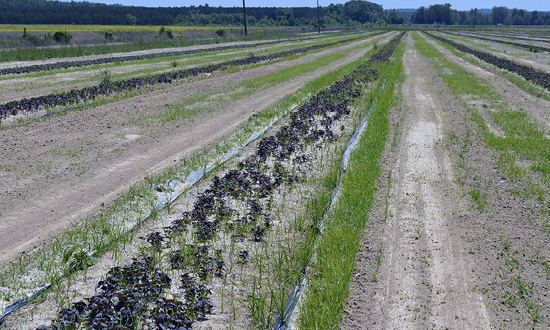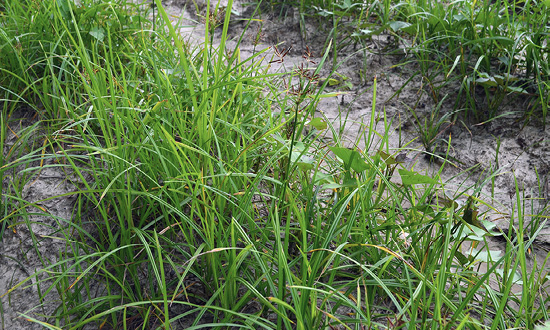Nutsedge Management in Mississippi Sweetpotatoes
Nutsedges (Cyperus spp.), sometimes referred to as “nutgrasses” because they resemble grasses, are among the most common and troublesome weed species in Mississippi sweetpotato plant beds and production fields (Figure 1). Nutsedges can be distinguished from grasses by examining their stems. Grasses have round or flat stems, and nutsedges have triangular stems.


Figure 1. Yellow nutsedge in sweetpotato plant propagation beds (top). Yellow and purple nutsedge in a sweetpotato production field (bottom).
Once nutsedges become established, they compete with the sweetpotato crop for light, soil moisture, and nutrients. In addition, nutsedge rhizomes can penetrate sweetpotato storage roots, causing them to be non-marketable and difficult to sell.
Several nutsedge species exist, but they differ in their biology and management. The proper management strategy begins with proper identification.
Identification and Biology
Yellow and Purple Nutsedge
Yellow nutsedge (Cyperus esculentus L.) and purple nutsedge (Cyperus rotundus L.) are perennial weed species. They spread by underground stems called rhizomes (Figure 2). These rhizomes spread out from the mother plant to form either a new shoot (daughter plant) or a starchy tuber. Tubers (Figure 3) are the primary way yellow and purple nutsedges reproduce. The mature tubers (i.e., nuts or nutlets) become dormant and overwinter in the soil. Once favorable environmental conditions occur the following spring, dormancy is broken and tubers begin to produce new sprouts. Yellow nutsedge tubers have a mildly sweet taste and form at the end of a rhizome.


They are often consumed by wildlife including wild turkeys and wild hogs. Purple nutsedge tubers are bitter and often form along the entire length of the rhizome. Yellow nutsedge leaves are yellow-green and have a long, tapered point (Figure 4). Purple nutsedge leaves are deep green and come to an abrupt point. Inflorescences (i.e., groups of flowers) are straw-colored on yellow nutsedge and reddish-purple on purple nutsedge (Figure 5).


Annual Sedge and Rice Flatsedge
Annual sedge (Cyperus compressus L.) and rice flatsedge (Cyperus iria L.) (Figure 6) are also common sedges that occur in Mississippi sweetpotato fields, but they are not as problematic. However, they are worse in years with higher than average rainfall, and in field areas that are wet for an extended amount of time. Unlike yellow and purple nutsedge, these sedges are annual plants that reproduce by seed. They do not form rhizomes and tubers, but they can produce multiple inflorescences from a single shoot.


Figure 6. Rice flatsedge in a sweetpotato production field (top); close-up of inflorescence (bottom).
Nutsedge Interference
Studies conducted in Mississippi in 2013 and 2014 revealed that even at relatively low densities, yellow nutsedge can reduce sweetpotato yield significantly. In 2013, a single nutsedge shoot per square foot of hipped row at 2 weeks after transplanting resulted in a 41 percent reduction in No. 1 sweetpotato yield and a 32 percent reduction in marketable yield compared to a hand-weeded check. In addition, No. 1 yield was reduced 85 percent and marketable yield was reduced 70 percent with five nutsedge shoots per square foot.
In 2014, a growing season with more consistent soil moisture, the impact was not as severe. One nutsedge shoot per square foot reduced No. 1 and marketable yields by 14 percent each. Five nutsedge shoots per square foot reduced No. 1 yield 53 percent and marketable yield 49 percent. Yellow nutsedge reduced yield and it also reduced quality by piercing sweetpotato storage roots with its shoots, tubers, and rhizomes (Figure 7).




Figure 7. Yellow nutsedge shoots, rhizomes, and tubers in sweetpotato storage roots.
Management
In-season nutsedge control strategies are limited in sweetpotatoes due to a lack of chemical control options. Repeated in-season mechanical tillage with a rolling cultivator will suppress nutsedge plants between rows, but it will also move nutsedge plants and tubers down the row with the cultivation equipment. Wick and wiper applications can be limited because the height difference between nutsedge shoots and sweetpotato vines is typically small. The best management strategy for nutsedge includes a combination of equipment sanitation, crop rotation, and pre-emergence herbicides.
Sanitation
When moving from a nutsedge-infested field to a clean one, it is important to avoid transporting nutsedge shoots, rhizomes, and/or tubers on equipment including discs, do-alls, hippers (row bedding equipment), transplanters, cultivators, and harvesters. Before moving equipment, remove as much soil as possible and any visible nutsedge plant structures. Harvesting equipment is especially notorious for transporting nutsedge from field to field.
Crop Rotation
Although registered herbicides for nutsedge control are limited in sweetpotatoes, growers who rotate to certain row crops or cover crops may have more control options. Additionally, crops with more upright growth habits are more competitive with nutsedge for light. Sulfonylurea- tolerant soybeans and corn are two great options. Heavily infested fields should be grown in these crops for at least two growing seasons to diminish the nutsedge population before returning to sweetpotatoes.
Fallow
Fallow fields are those that are not planted with a crop. This option is particularly useful for late-harvested plant beds with heavy nutsedge infestation. After slips are harvested, the field can be disked and treated with pre- emergence herbicides. If nutsedge shoots emerge later, a post-emergence herbicide treatment can be applied. When the initial flush of sedge has died, disc again to encourage buried tubers to sprout, and re-treat emerging shoots with a post-emergence herbicide treatment. Refer to MSU Extension Publication 1532 Weed Control Guidelines for Mississippi for more information on herbicide efficacy. Always be mindful of the plant-back intervals and rotation restrictions for the products you use.
Pre-emergence Herbicides
Dual Magnum (active ingredient S-metolachlor) is currently the only herbicide registered for sweetpotatoes that provides yellow nutsedge control. Dual Magnum is a pre-emergence herbicide and will not control nutsedge after it has emerged. While it is usually recommended that applications of this herbicide be delayed until 10 to 14 days after transplanting, doing so limits its usefulness for managing nutsedge because it can emerge shortly after transplanting. If Dual Magnum is applied before 10 days after transplanting, it should be applied only to fields with a history of nutsedge infestation and at a rate no greater than 12 ounces per acre. Combining Dual Magnum in a tank-mixture with 2.66 pints of Command (active ingredient clomazone) improves nutsedge control when applied before nutsedge emergence. Weed control efficacy is also dependent upon an activating rainfall or irrigation event to move the herbicide(s) into the soil where nutsedge plants are actively growing.
The information given here is for educational purposes only. References to commercial products, trade names, or suppliers are made with the understanding that no endorsement is implied and that no discrimination against other products or suppliers is intended.
Publication 2909 (POD-04-22)
Revised by Lorin M. Harvey, PhD, Assistant Professor, and Mark W. Shankle, PhD, Research Professor, Pontotoc Ridge Flatwoods Branch Experiment Station, from a previous version by Stephen L. Meyers, PhD, former Assistant Extension/Research Professor, and Mark W. Shankle.
The Mississippi State University Extension Service is working to ensure all web content is accessible to all users. If you need assistance accessing any of our content, please email the webteam or call 662-325-2262.




